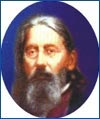A very absurd combination ; anthracite coal of a certain kind, dissolved in boiling caustic potash, invented by Joseph Polya, in Pesth, in 1835 ; proved on many people, but in a very superficial way.
Applied according to Old School notions, but seldom alone.
Polya was followed by several others, and in 1839 a thesis by one C. F. Klinger ; in 1840, an extract by our Dr. G. Piper, in the A. H. Z., Vol. XVIII., p. 235 and 253. It was mentioned as a “renal” remedy by Reil, the forerunner of Sharp, of organopathic notoriety, and in 1849 Chapman mentions it as having been “useful”, but says nothing but “herpes.”
It has never been much regarded and was of very little use. The Old School made one of their experiments in 1841, and gave it to eight hundred patients with “tetter”, in the Vienna hospital, without success.
SMELL AND NOSE.
Chronic cracks and ulcerations of nostrils.
TASTE, SPEECH, TONGUE.
Taste : unpleasant, nauseous, disgusting.
Dirty tongue, no appetite, nausea.
Dirty tongue, with retching and colic.
INNER MOUTH.
Dry mouth and pharynx.
PALATE AND THROAT.
Warmth and hot feeling in pharynx, going down into stomach.
Burning in pharynx : followed by anorexia ; with dysphagia.
Pain in pharynx with a dirty tongue.
Dysphagia with dry throat.
Sensation of gnawing and scraping in oesophagus, soon disappearing and going down to stomach.
APPETITE, THIRST, DESIRES, AVERSIONS.
Anorexia, nausea, vomituritio.
Increased appetite.
Burning thirst ; before sweat.
Insatiable thirst.
At first no appetite, but soon after it grew sharper.
EATING AND DRINKING.
After eating, nausea.
After an error in diet, a gastro-bilious fever, with erysipelas.
HICCOUGH, BELCHING, NAUSEA AND VOMITING.
Anorexia, nausea, vomiting, colic and flatulence.
Nausea and vomituritio.
Vomiting and bilious stools.
Bilious vomiting, with black phlegm, followed by too fluid stools.
SCROBICULUM AND STOMACH.
Cramplike pain in stomach.
Warm sensation in stomach.
ABDOMEN AND LOINS.
Colic with flatulence.
Violent colic at night > by a warm poultice.
Violent burning deep in abdomen, in evening.
Griping bellyache without diarrhoea.
Tympanitic distension.
STOOLS AND RECTUM.
After colic and rumbling several mushy stools.
Copious diarrhoea with colic and rumbling.
Diarrhoea for several days with increased secretion of urine.
Three times during the day a brown stool with increased quantity of pale urine.
** Cholera.
URINARY ORGANS.
Tickling and burning in urethra and at orifice, while water passes.
Ischuria, urine pale.
Some diuresis.
Copious evacuations of pale, clear urine, without a sediment.
Urine pale, acrid, increased.
Urine pale, honey-colored, of unpleasant odor, strongly alkaline reaction, rarely saturated and sharp, very seldom with a nubecula, never a sediment.
When urinating orifice of urethra itches.
MALE SEXUAL ORGANS.
Very often long lasting painful erections.
Frequent erections.
** Sycosis.
FEMALE SEXUAL ORGANS.
Catamenia appeared before the time.
HEART, PULSE AND CIRCULATION.
Orgasm with heat of skin.
Slight vascular irritation.
Pulse excited.
In evening increased heat with frequent, full pulse.
Pulse and temperature feverish.
The beating of heart sometimes stronger, with oppression, pressing headache nightly, restlessness and no sleep.
Pulse quicker, frequent and more full.
UPPER LIMBS.
Eruption on hands.
NERVES.
Debility of whole body, with restlessness and heavy head.
Complete malaise.
TIME.
Eruptions decrease with full of moon.
Evening : increased, heat with frequent full pulse ; night sweats begin.
At night : colic ; copious warm sweat ; skin itches.
TEMPERATURE AND WEATHER.
Colic at night relieved by warm poultices.
After baring skin night sweat.
FEVER.
Horripilation alternating with heat, followed by slight sweat and frequent pulse.
Heat and pressure in stomach.
Febris evanida, with disturbed digestion.
After baring of skin, night sweats, continuing for several days.
Skin moist for two successive days.
Evening copious sweat lasting till morning.
General night sweat, returning every night.
Local cold or warm sweat on parts affected by an eruption.
After a viscous night sweat remission of fever.
Sweat viscous, skin remains shining, glistening.
After heat and itching skin moist.
Often a general sweat commencing at night and continuing till morning hours.
Copious warm night sweat with dizzy head.
Night sweat copious with sleeplessness and greatest restlessness, but less pain in bowels.
With sweat restlessness, headache, debility and frequent pulse.
Moderate night sweats beginning in evening with sleeplessness and excited pulse.
ATTACKS, PERIODICITY.
Sweats : return every night ; pressing headache.
Three times a day : brown stool.
Sweats continue for several days.
A reaction takes place always before the eighteenth day.
Pain : in pharynx.
Hot feeling : in pharynx, going down into stomach.
Burning : in pharynx.
Cramplike pain : in stomach.
Violent colic.
Violent burning : deep in abdomen.
Pressure : in stomach.
TISSUES.
** Chronic rheumatism, gout, caries, scrofulosis.
SKIN.
Itching at night.
Eruptions increase with general sweat, get more red and ooze out more.
Urticaria or erysipelas.
** Scabies : with ecthyma ; with prurigo.
Scabies.
Prurigo.
Eczema impetiginoides.
Impetigo scabida.
** Lichens.
Useful in cases of chronic herpes.
Herpes circumscriptus.
RELATIONS.
Compare with the carbons.
Similar to : Acon. (diarrhoea with copious flow of urine) ; Antimonium crud. and Arsen. (thirst, burning and nausea, skin) ; Bryon., Carbo animalis, Carbo veg. and Kali carb. (in flatulency, etc.) ; Rhus tox. (in skin symptoms) ; Veratr. (in nausea, vomiting, colic and diarrhoea).
Given in connection with Dulcam. in sycosis, scabies, prurigo, and impetigo ; with Ferrum jod. in eczema, impetigonoides.
Tapeworm has been removed by pulverized anthracite coal.
“NOTE:
PLAIN TEXT : LOWEST & DESIGNATES AN OCCASIONALLY CONFIRMED SYMPTOMS;
Plain blue: MORE FREQUENTLY CONFIRMED;
BOLD BLUE : SYMPTOMS VERIFIED BY CURES;
BOLD RED : REPEATEDLY VERIFIED;
$BOLD ITALIC RED$ : AN APPROVED CHARACTERISTIC;
θ : STANDS BETWEEN CURED SYMPTOM & PATHOLOGICAL CONDITION;
** : OBSERVED FROM OLD SCHOOL OR NEW SCHOOL;
toxic : Toxicology;
r : Right;
l : Left;
< : Increased or aggravation;
> : Decrease or amelioration;
^^ : Symptoms observed only on the sick “

